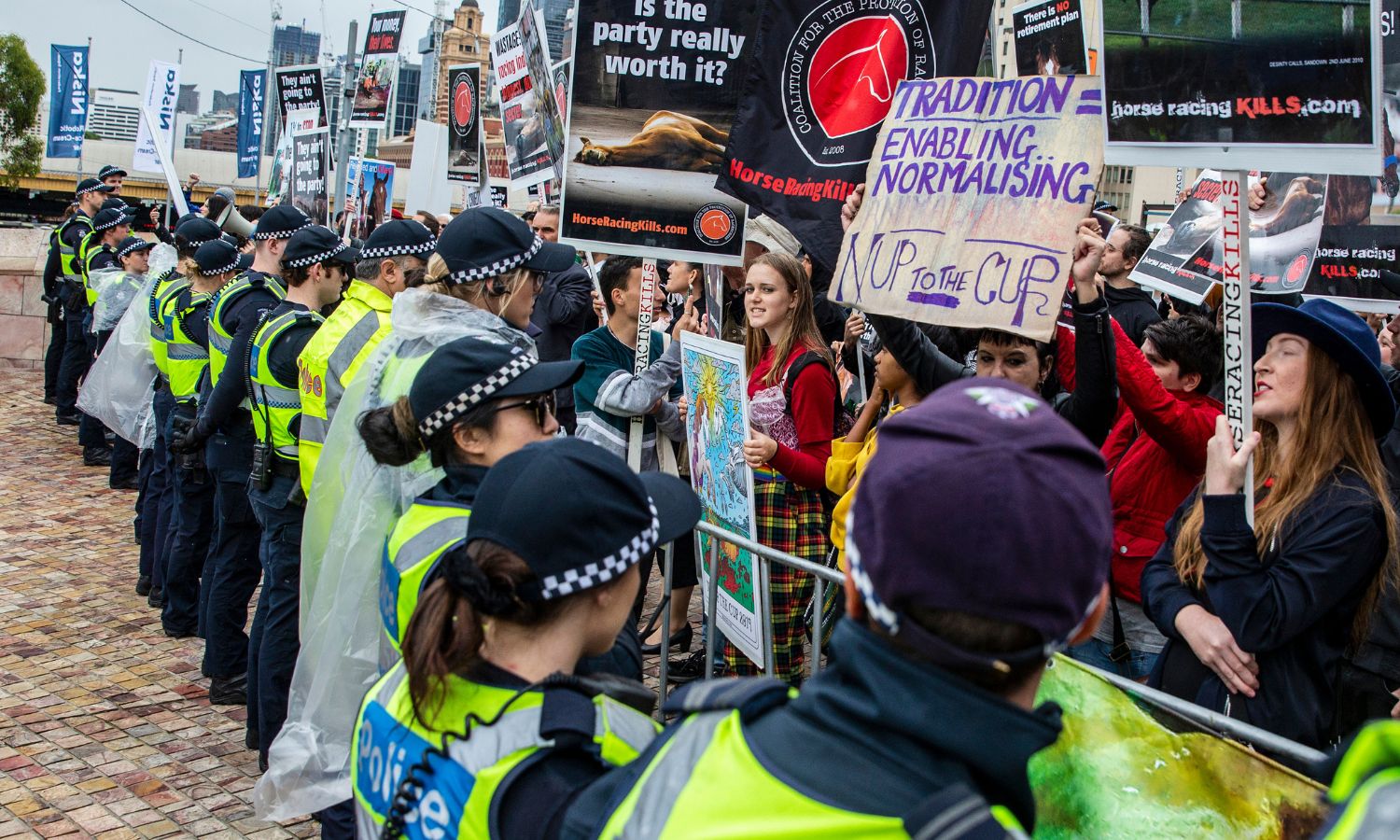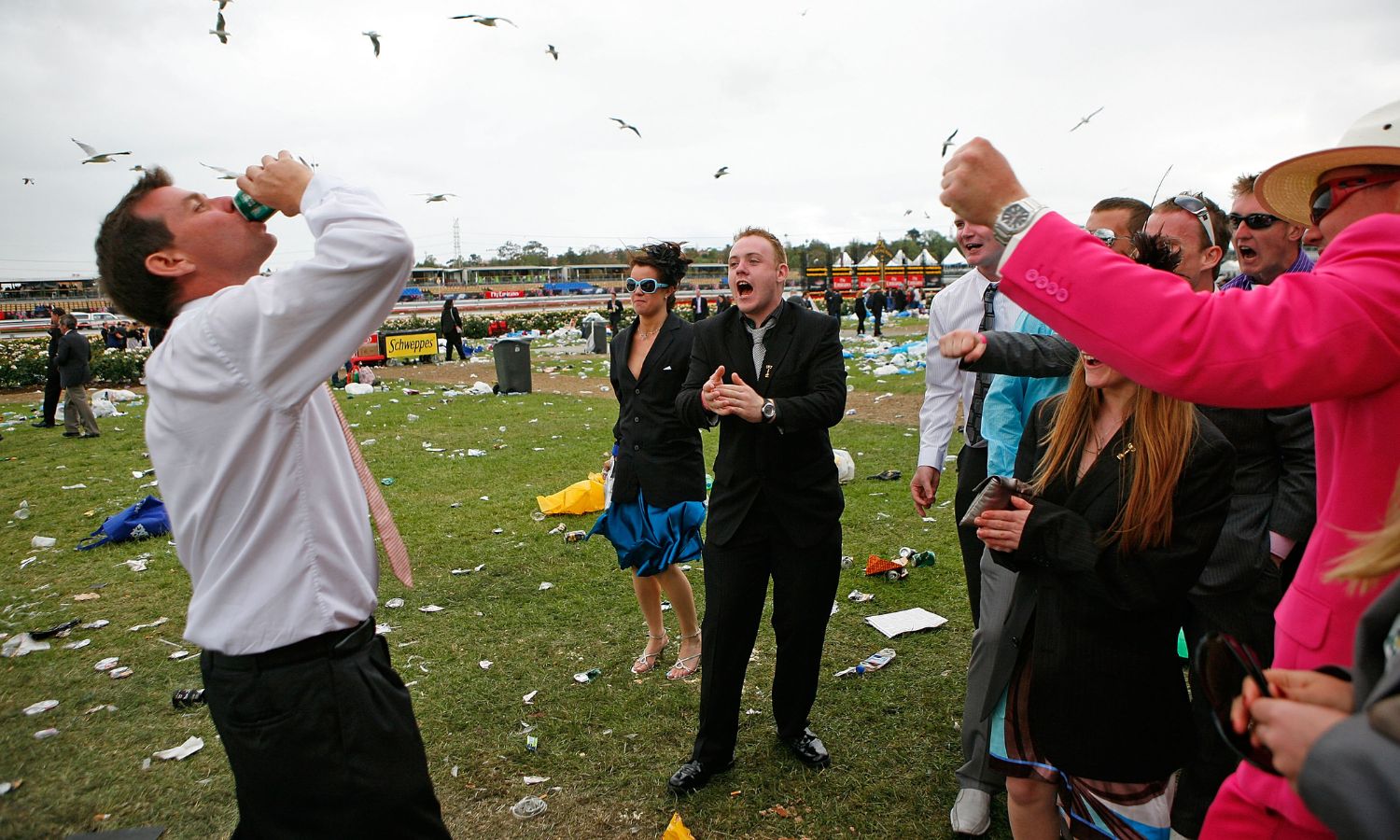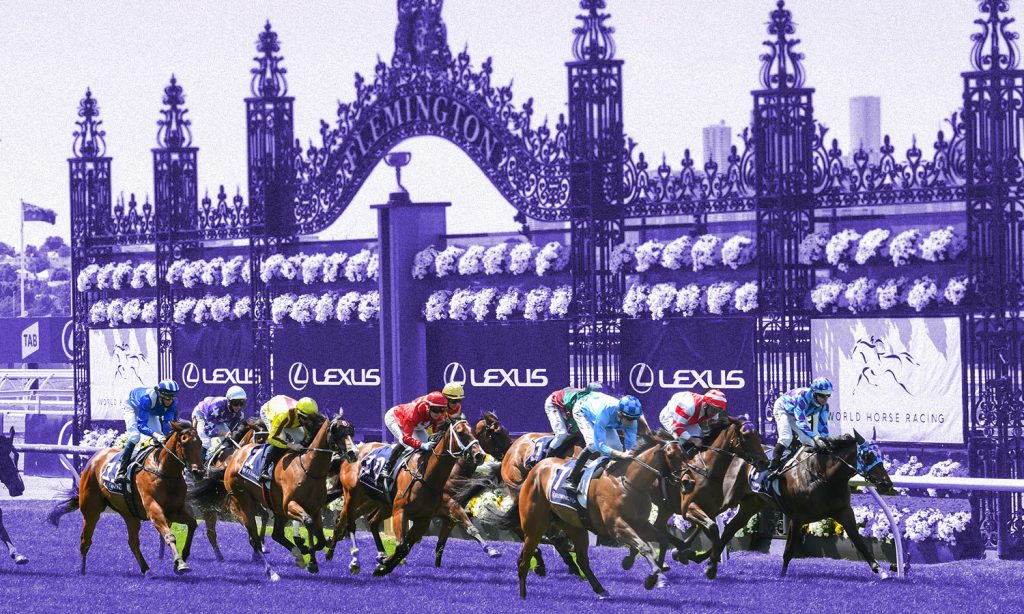For better or worse, and it’s usually for the worse, Australia is a nation of gamblers. In the gambling calendar, there is no bigger event than the Melbourne Cup.
Each year, millions are wagered by Aussies hoping to cash in on the historic race at Flemington, with long lunches and public holidays galore across the country. ‘Sick days’ spike by 25% the following day as some 1.2 million viewers indulge.
It’s no secret that we’ve long been falling out of love with ‘the race that stops the nation’, the collective value of the annual flutter may now be the only thing keeping it propped up.
Attendance at the track has been dropping over the past eight years since it topped out at 100,000 in 2015. Viewership is also significantly down. While the Cup was once associated with all-Aussie sportsmanship, but it is increasingly symbolic of a certain type of Australia — the wealthy, white, and wasted.
Looking back, you can almost pinpoint how and when our understanding of the race shifted. If you had to stick a date on it, 2019 is a strong contender for the watershed year in which the Melbourne Cup became a byword for problem gambling, animal abuse, and inequality. Although such understandings had been flying around for decades prior, this is when they really started to stick. It’s a characterisation that the Victorian Racing Club, which owns Flemington, has been unable to shake ever since.
That year saw trending hashtags ‘nup to the cup’ and ‘you bet they die’ start trending for the first time. It was the same year that celebrities, including Taylor Swift, pulled their support, with Swift cancelling a scheduled performance over pressures from animal rights activists. Perhaps the change in sentiment had something to do with the fact that the previous year had seen Irish Thoroughbred The Cliffsofmoher euthanised on the track after he fractured a shoulder in 2018. He was the 6th to die during the festival in seven years.
2019 was also the year that the ABC showed footage of retired racehorses being taken to slaughterhouses. Nup to the Cup campaign leader Kristin Leigh has described that news piece as a tipping point.

Since then, support for the Cup has been in freefall. Even before the COVID pandemic put a pause on crowds, nearly 20,000 fewer people bought tickets in 2019. Last year, that attendance dropped to 73,816, the lowest since 1995. Research commissioned by the Greens in 2022 found that 54% of Australians thought horses shouldn’t be raced for gambling purposes and 59% thought that the practice was cruel.
Sensing a change in the wind, MYER has ended its almost 40-year partnership with the VRC, leaving the Fashions on the Field competition without a sponsor for 2023. One influencer agency has reportedly said that their talent will go to the Cup on behalf of clients but are refusing to be photographed in attendance so as not to be associated “with something that’s so controversial.”
Of course, the VRC is fighting back against cultural irrelevance. This year, they’re allowing men to wear tailored shorts instead of the customary trousers and will launch a music festival, Palooza, with a packed dance music lineup.
This said the corporations pulling the strings may have overstepped the mark this year in a bid to shake things up — fatally, by some judgements. Tabcorp, which holds the rights to the Melbourne Cup, managed to lose both Network Ten and Seven this year after they decided to add far more gambling-based content to their coverage.
“It became clear that the nature of the agreement between Tabcorp and the VRC would require a move towards a core racing and wagering-focused broadcast product,” Ten said in a statement.
The company declined to renew the five-year agreement to show the races which they settled in 2018 for $100 million. After some back and forth, Channel Nine will now show the race from 2024 onwards after inking a six-year deal worth a significantly reduced $40 million.
Whether this doubling down on a ‘wagering focus’ will hasten the Cup’s decline remains to be seen but, as long as the money continues to roll in for the sport, it’s clear that it will race on. And the figures it draws are truly astounding.
How Much Australians Gamble on the Melbourne Cup
This year, the prize pool sits at $8.41 million and the winning team will take home $4.4 million. The real winners however are not the horses who place nor the people who backed them but the gambling corporations for whom the Melbourne Cup is serious business. The prize money is chump change when compared to the nearly three-quarters of a billion wagered on the races across the four-day carnival.
The TAB, Sportsbet, Bet365, and Ladbrokes are the big four in this space. Combined, they suck up some 93.92% of online traffic to gambling sites during the Cup, according to data from 2021. Internet activity to those sites spiked by a whopping 254% in 2020 during the festival, when lockdown measures were still very much in place and jumped by a not-insignificant 179% in 2021.
In 2012, Aussies bet some $150 million on the Melbourne Cup, while in 2021, that figure had grown to $223.8 million. Although the gambling industry is not known for its openness, making true figures hard to come by, it appears that horse racing is faring better than most.
The latest figures from the Australian Institute of Health and Welfare show that gambling overall is down, with just 35.2% engaging in any kind of punt in 2018 compared to 39% in 2105. In the same period, 6.2% of the nation bet on horse or dog racing, up by 0.6% since 2015. Monthly expenditure is also up significantly, with the typical gambler wagering $121.9 on horse or dog races in 2015, increasing to $232.5 in 2018.

Analysis by Finder in 2021 found that, on average, Australians bet almost $88 on the Melbourne Cup each, although this is likely blown out by many placing larger bets.
In 2014, figures show that more than $300 million was wagered on the Cup, much of which came from once-a-year gamblers like every year. At the time, TAB boss Craig Nugent told The Sunday Times that “fixed-odds betting has just taken off in Australia.”
“We’ve grown from a $42 million business in our first year to $4.2 billion in 16 years.”
By 2019, however, those figures appeared to be on the wane. TAB recorded a 7.8% decline in turnover on the big race from 2018, a decrease of $8.26 million.
“Punting Advocate”, Richard Irvine, told The Sydney Morning Herald at the time, that “The market’s a bit depressed; it didn’t really change for the Melbourne Cup.”
Total expenditure is still vast, though. In 2020, Australians bet $221.6 million on the Melbourne Cup’s main run. That’s just part of the $667.3 million spent across the four-day carnival. While the betting on the main race was up by 17% on 2019 figures, overall turnover for the day was down by $24 million on the previous year. In 2021, those numbers bounced back, with $223.8 million bet on the cup race. $724.1 million was spent across the four days, an increase of 7.6% on 2020.
While gambling companies take a serious slice of one of the world’s richest racing pies, the government still takes the lion’s share. Economic return on the Cup for the state of Victoria is estimated to be around $447.6 million — a 20% increase since 2014. More broadly, government revenue raised from gambling taxation has risen by $1 billion over the past decade to $6.5 billion in 2022.
Money talks, but so do politicians, and it appears that the race is becoming increasingly at odds with a government that has decided to at least start trying to look like it’s doing something about problem gambling – a scourge that costs us, financially alone, some $25 billion each year.
New advertising standards and the rumblings of major reform following the gambling inquiry recommendations in June have emerged while states and territories have started walking the talk with anti-gambling measures.
In July, the Victorian government introduced “sweeping” new reforms requiring the use of pre-paid gambling cards in pokie machines.
“Our previous reforms have delivered stronger oversight of the gambling industry in Victoria with a regulator unafraid to hold venues to account – now we’re doing more important work to reduce gambling-related harm,” Minister for Casino, Gaming and Liquor Regulation Melissa Horne said at the time.
While racing was left out of the chances, it’s hard to see how such a stance can sit alongside the nation’s biggest celebration of gambling. Perhaps we should consider – humanely, privately – putting this sordid show out of its misery.
Related: The Invisible Issue of Melbourne Cup Day
Related: Flemington Racecourse’s Flood Wall Is Everything Wrong With Australia Right Now
Read more stories from The Latch and subscribe to our email newsletter.







